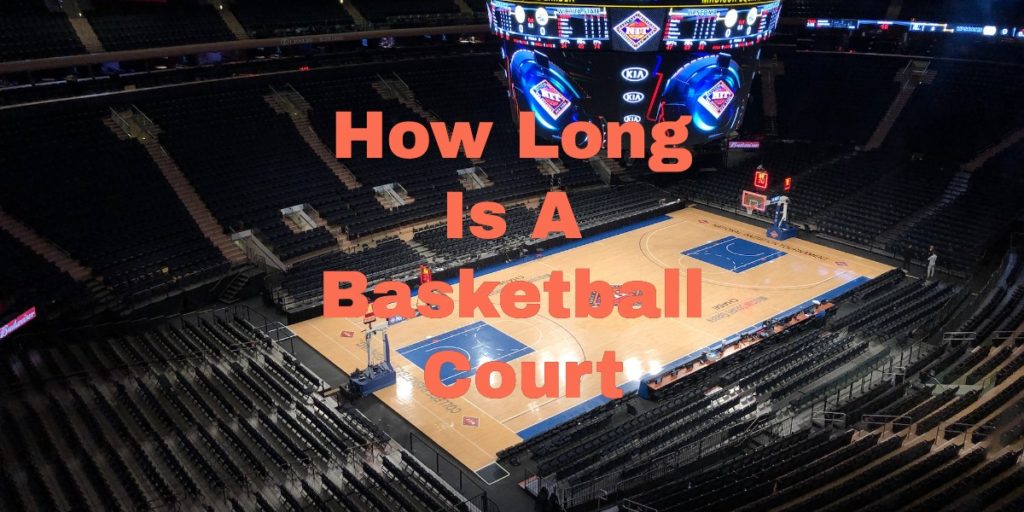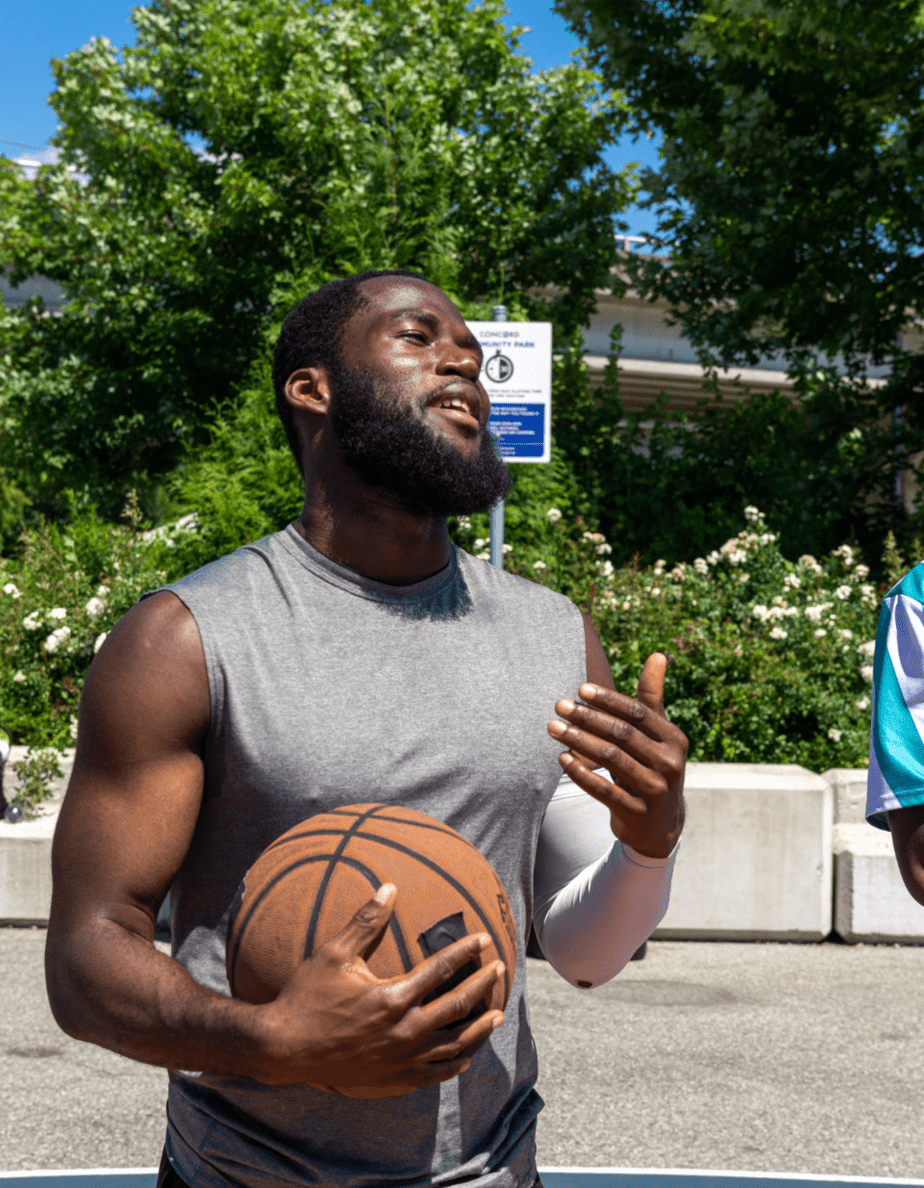How Long Is A Basketball Court: NBA, FIBA College, and High School
How long is a basketball court? The length can vary depending on the level of play. But, I have researched it and put together a table below with the answer based on the level of play (NBA, FIBA College, and High School).
| League\Level | Length (meters) | Length (feet) |
|---|---|---|
| FIBA | 28.0 | 91.86 |
| NBA | 28.65 | 94 |
| NCAA | 28.65 | 94 |
| High School | 25.6 | 84 |
How Long is a Basketball Court In Yards
In case you want to cut and paste this and just want it in yards here is the length in just yards.
| League\Level | Length (yards) |
|---|---|
| FIBA | 30.66 |
| NBA | 31.5 |
| NCAA | 31.5 |
| High School | 28 |
| Junior High | 24.67 |
History Of The Length Of A Basketball Court
The size of a basketball court has remained relatively unchanged since James Naismith invented the game in 1891. However, back then, there were no set dimensions and courts could be as small as a backyard or as large as a tennis court. It wasn’t until 1904 when the first official rules were established and the court size was standardized.
The first official basketball game was played in the YMCA gymnasium in Springfield, Massachusetts, which had working dimensions of 50 feet by 33 feet. To keep the game moving quickly, Naismith decided that the baskets should be placed 10 feet above the ground – a height that has also remained standard ever since.
While the dimensions of a basketball court may not seem that important, they play a big role in how the game is played. For instance, the length of the court affects how fast the game is played and how much space the basketball players have to operate.

Official Basketball Court Dimensions
To kick things off, let’s talk about the official basketball court dimensions according to the three primary organizations that govern the sport.
International Basketball Federation (FIBA) Regulations
The International Basketball Federation (FIBA) oversees basketball worldwide, and their court dimensions are as follows:
- Court length: 28 meters (91.86 feet)
- Court width: 15 meters (49.21 feet)
There are some key differences between FIBA and other basketball organizations, which we’ll discuss below.
National Basketball Association (NBA) Regulations
The NBA has its own set of court dimensions:
- Court length: 94 feet (28.65 meters)
- Court width: 50 feet (15.24 meters)
The NBA court is slightly longer and wider than the FIBA court, which is something to keep in mind when comparing the two leagues. The NBA also has some unique features and specifications, such as a larger restricted area and a deeper three-point line.
National Collegiate Athletic Association (NCAA) Regulations
The NCAA governs college basketball in the United States, and their court dimensions are:
- Court length: 94 feet (28.65 meters)
- Court width: 50 feet (15.24 meters)
The dimensions are identical to those of the NBA, but there are some differences in markings and rules that affect college basketball gameplay.
High School Basketball Court Dimensions
High school basketball court dimensions can vary depending on the state and school district. However, the most common dimensions are:
- Court length: 84 feet (25.6 meters)
- Court width: 50 feet (15.24 meters)
The high school court is shorter than both the NBA and NCAA courts, which can have a significant impact on player development and game strategy.
Half-Court Basketball Dimensions
Half-court basketball is popular for recreational games and practice. The standard dimensions for a half-court are typically:
- Court length: 47 feet (14.33 meters)
- Court width: 50 feet (15.24 meters)
Playing on a smaller court offers several benefits, such as requiring less space and promoting a more intimate game.
Differences in Court Dimensions: Indoor vs. Outdoor
Court dimensions can also vary depending on whether the game is played indoors or outdoors. Let’s dive into some of the differences.
How Court Materials Affect Dimensions
Indoor courts usually have a hardwood surface, while outdoor courts are often made of asphalt or concrete. These material differences can lead to slight adjustments in court dimensions due to the expansion and contraction of materials in different weather conditions.
Common Adjustments for Outdoor Courts
Outdoor courts are often slightly smaller than indoor courts to accommodate space constraints in parks and recreational areas. It’s not uncommon for outdoor courts to have markings for other games. The materials for an outdoor basketball court tend to be asphalt, concrete, or rubber.
The Role of The Court
Court dimensions play a role in basketball strategy. Let’s explore how they impact the game.
How Court Size Affects Player Movement and Spacing
Larger courts require players to cover more ground, which can lead to increased fatigue and affect the team’s overall performance. On the other hand, smaller courts demand better ball control and precise passing to navigate through tighter spaces.
Impact on Offensive and Defensive Strategies
Different court sizes can influence the game’s pace and the choice of offensive and defensive strategies. For instance, larger courts can favor fast-break offenses and aggressive defenses, while smaller courts might encourage more half-court sets and compact defensive schemes.
The Importance of Adjusting to Different Court Sizes
Players and coaches need to be adaptable when transitioning between various court dimensions. This adaptability can be important, especially when competing in different leagues or tournaments that use varying court sizes.
Conclusion
Understanding how long a basketball court is can be important for players and coaches. We’ve covered the official lengths for FIBA, NBA, NCAA, high school, and half-court games, as well as the differences between indoor and outdoor courts. Keep these dimensions in mind as you watch or play basketball, and you’ll develop a deeper understanding of how court size impacts strategy and performance.
Frequently Asked Questions (FAQs)
How are basketball courts measured?
Basketball courts are measured from the outer edge of the boundary lines, which include the end lines and sidelines. The length is the distance between the two end lines, while the width is the distance between the two sidelines.
Why are there different court dimensions for various levels of play?
Different court dimensions cater to the diverse needs and skill levels of players. For example, high school courts are shorter to account for younger players’ physical abilities, while professional leagues like the NBA have larger courts to showcase athletes’ elite skills.
Can a court be customized for personal use?
Absolutely! If you’re building a personal court, you can customize the dimensions to fit your available space and preferences. Just keep in mind that playing on a non-regulation court might affect your ability to transition to regulation courts in competitive settings.
Troy Wallace
Troy Wallace is Certified Basketball Speed Specialist and shares his experiences in trying to stay as healthy as possible to stay on the court. He is active in coaching youth basketball in YMCA, Team Work Sports Nebraska, and, currently, in the Jr. Warriors program in Omaha, NE. Visit Troy's Full Author Bio Page or email him directly.
Meaningful conversations happening daily about training, recovery, and injury-specific rehabilitation as well as sport-specific discussions on playing, coaching and refereeing your favorite sport. We welcome experts and those with curious minds seeking answers.
Join The Stay On The Court Community!